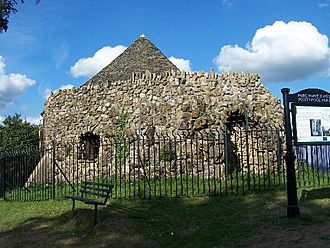Shell Grotto, Pontypool facts for kids
Quick facts for kids Shell Grotto |
|
|---|---|
|
Welsh: Groto Cregyn
|
|

The Shell Grotto in Pontypool Park
|
|
| Alternative names | Shell Hermitage |
| General information | |
| Status | Complete |
| Type | Grotto |
| Architectural style | Stone with slate roof |
| Location | Pontypool Park, Torfaen, South Wales |
| Town or city | Pontypool |
| Country | Wales |
| Coordinates | 51°42′11″N 3°01′22″W / 51.7031°N 3.0227°W |
| Elevation | 700 ft (213 m) above sea level |
| Completed | 1784 |
| Renovated | 1993 to 1994 |
| Client | John Hanbury |
| Owner | Torfaen County Borough Council |
| Height | 29 ft (9 m) |
The Shell Grotto (called Groto Cregyn in Welsh) is a super cool building in Pontypool Park, Torfaen, south Wales. It's a round stone building with a slate roof. Inside, it's covered with thousands of shells and animal bones! It was built in the late 1700s.
This special grotto stands high up on a ridge, about 700 feet (213 meters) above sea level. It's thought to be the best surviving grotto in Wales. It's an important local landmark because it offers amazing views south towards the Severn Estuary. Not far from it, you can also find the Folly Tower.
A Look Back in Time
The Shell Grotto was ordered by a man named John Hanbury. He wanted it as a place for hunting trips or a summer house. The Hanbury family were important ironmasters in the area and owned Pontypool Park.
Later, in the early 1800s, John's relative, Capel Hanbury Leigh, updated the family house and park. People believe his wife, Molly Ann, was the one who decorated the grotto's inside with shells. Molly was known for collecting shells. She even built another shell grotto near her home at Gnoll.
Shell decorations were popular in grottoes during the 1800s. So, it makes sense that Molly might have started this amazing shell artwork. The Hanbury family used the grotto for picnics, especially during hunting trips. In 1882, it's said that the Prince of Wales (who later became King Edward VII) had a picnic there!
How It Was Built
The grotto is made from local red stone called Pennant sandstone. It has a cone-shaped roof made of stone tiles. Inside, the roof looks like a fan, with six sections rising from six pillars.
These pillars and the ceiling are covered with thousands of shells. You can also see minerals and real stalactites that were brought from local caves. The main walls inside are mostly bare stone, but some have shiny calcite crystals stuck in them.
On the floor, you'll find animal bones and teeth arranged in cool shapes like arcs, circles, stars, hearts, and diamonds. The grotto also has two windows with colored glass.
Bringing It Back to Life
Over time, the grotto started to fall apart. By the early 1990s, weather and vandals were causing a lot of damage. The roof had fallen in, and some outer walls were crumbling. Because of this, people couldn't visit the grotto after the 1970s.
It was clear that without repairs, the grotto could be lost forever. Fixing it was going to be very expensive. The local council looked for help from other groups to pay for the work.
Some small roof repairs happened in 1992, but the grotto still needed a lot of help. In 1992 and 1993, important groups like the Welsh Heritage Authority (Cadw) and the European Regional Development Fund stepped in. They helped get enough money to completely restore the building.
The outside of the grotto was fixed over eight months in 1993 and 1994. This included repairing damaged stone, fixing the chimney, replacing roof timbers, adding a new roof, and putting in a new door and windows. This outdoor work cost £75,000.
Even though the outside was finished by summer 1994, the amazing shell interior was still a mess. The collapsed roof, weather, and vandals had damaged it badly.
In 1995, a new effort began to raise money for the inside. More donations came from Cadw and the Heritage Lottery Fund in Wales.
The restoration of the shell interior started in 1996. A special team called St Blaise Ltd. worked carefully on the detailed plaster and shell designs. It took them four months to repair the ceiling, pillars, walls, and floors.
Luckily, photos of the shell interior had been taken years before. These pictures were super helpful to make sure the repairs looked exactly like the original. Many of the shells and minerals that had fallen off were saved. These, along with new materials, were used in the restoration. Most of the shells are British, like mussels, cockles, periwinkles, and limpets. There are also a few exotic ones, like pearl oysters, conch, and cowrie shells.
The restoration of this beautiful shell grotto was finished in December 1996. Now, people living in Pontypool and visitors can once again explore the grotto and enjoy its stunning shell interior and wide views.
Some of the root-like decorations on the walls and ceiling had worm damage. To make them strong again, a special resin mixture was carefully injected into the holes. This made the structures solid once the liquid dried.
The rustic chairs inside were also fixed. Missing parts were added, broken sections were repaired, and old layers of paint were removed. The chairs were originally painted a dull green color in the mid-1800s. New wood pieces needed painting, so all the chairs were repainted to match that original color.
Visiting the Grotto
Getting to the Shell Grotto involves a steep climb. The ground can be uneven, so it might be a bit tricky to access.

